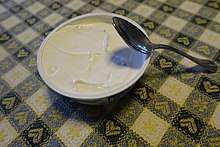Mascarpone
Mascarpone (/ˌmæskɑːrˈpoʊneɪ, -ni/, US also /ˌmɑːsk-/, Italian: [maskarˈpoːne]) is an Italian cream cheese coagulated by the addition of certain acidic substances such as lemon juice, vinegar or citric acid.[1][2][3] It is recognized as a prodotto agroalimentare tradizionale (PAT) ("traditional regional food product").[4]
| Mascarpone | |
|---|---|
 Mascarpone cream | |
| Country of origin | Italy |
| Source of milk | Cow |
| Texture | Soft |
Production process
After denaturation, the whey is removed without pressing or aging. Mascarpone may also be made using cream and the residual tartaric acid from the bottom or sides of barreled wine.
The traditional method is to use lemon juice at the rate of three tablespoons per pint of heated heavy cream. The cream is allowed to cool to room temperature before it is poured into a cheese cloth-lined colander, set into a shallow pan or dish, and chilled and strained for one to two days.[5]
Origins
Mascarpone originated in the area between Lodi and Abbiategrasso, Italy, southwest of Milan, probably in the late 16th or early 17th century. The name is popularly held to derive from mascarpa, an unrelated milk product made from the whey of stracchino (a young, barely aged cheese), or from mascarpia, a word in the local dialect for ricotta. Ricotta, unlike mascarpone, is made from milk and not cream.
Uses
Mascarpone is milky-white in color and is easy to spread.[6] It is used in various Lombardy dishes, and is considered a specialty in the region.[7] It is one of the main ingredients in the modern Italian dessert known as tiramisu,[8] and is sometimes used instead of, or along with, butter or Parmesan cheese to thicken and enrich risotto.[9] Mascarpone is also used in cheesecake recipes.[10][11]
See also
References
- "Mascarpone Artigianale" (in Italian). Archived from the original on 2 April 2012. Retrieved 22 September 2011.
- Turismo Provincia di Lodi (2004). "Mascarpone" (in Italian). Retrieved 22 September 2011.
- Tessa Buratto (2010). "Mastering Mascarpone: What it takes to make a perfect batch of Mascarpone Cheese". San Luis Obispo, CA. Retrieved 8 April 2015.
- Regione Lombardia. "Elenco dei prodotti agroalimentari tradizionali della Regione Lombardia – Quinta revisione" (in Italian). p. 6. Retrieved 22 September 2011.
- David B. Fankhauser. "Making Mascarpone at Home". U.C. Clermont College-Batavia, OH. Archived from the original on 2007-04-09.
- Lidia Matticchio Bastianich (27 October 2015). Lidia's Mastering the Art of Italian Cuisine: Everything You Need to Know to be a Great Italian Cook. Appetite by Random House. pp. 107–. ISBN 978-0-449-01623-7.
- Luigi Veronelli (23 October 2012). Food of North Italy: Authentic Recipes from Piedmont, Lombardy, and Valle d'Aosta. Tuttle Publishing. pp. 31–. ISBN 978-1-4629-0976-6.
- Jason Atherton (18 June 2015). Social Sweets. Bloomsbury Publishing. pp. 87–. ISBN 978-1-4729-2080-5.
- Heston Blumenthal (2007). Further Adventures in Search of Perfection: Reinventing Kitchen Classics. Bloomsbury. pp. 140–. ISBN 978-0-7475-9405-5.
- Barbara Fairchild (14 September 2010). Bon Appetit Desserts: The Cookbook for All Things Sweet and Wonderful. Andrews McMeel Publishing. pp. 191–. ISBN 978-1-4494-0200-6.
- Victoria Wise (3 December 2004). The Pressure Cooker Gourmet: 225 Recipes for Great-Tasting, Long-Simmered Flavors in Just Minutes. Harvard Common Press. pp. 329–. ISBN 978-1-55832-201-1.
External links
